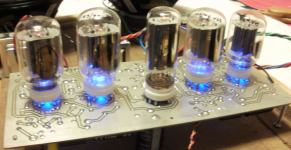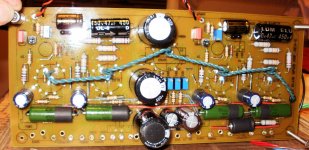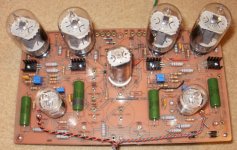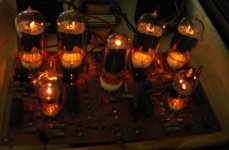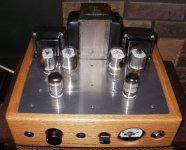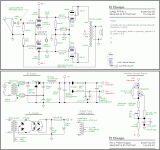My son is a mech. engineer and has offered to build me an amp if I come up with the schematic and parts. I started looking at books on valve amp theory and practice last night and ran into a theme in the comments that it is much more expensive to build than to buy a finished product. I assume this is because the cost of parts at retail is many times what they can be bought for in wholesale bulk. Perhaps these DIY amp builders are also placing a value on their time though I'm not concerned about that aspect of it.
My son works in a shop that makes fancy printers for the medical industry and has access to all sorts of test equipment. He thinks the kits I've found are too expensive and that he can build it from scratch much cheaper.
He has wholesale access to common electronic parts but not specialized items such as transformers.
My question is, is this true in your experience?
Assuming we engage the learning curve at a serious level and learn how to tune our result, are we able to build an amp that will rival a Sofia?
Thanks,
Mike
My son works in a shop that makes fancy printers for the medical industry and has access to all sorts of test equipment. He thinks the kits I've found are too expensive and that he can build it from scratch much cheaper.
He has wholesale access to common electronic parts but not specialized items such as transformers.
My question is, is this true in your experience?
Assuming we engage the learning curve at a serious level and learn how to tune our result, are we able to build an amp that will rival a Sofia?
Thanks,
Mike
IME, a commercially available product is usually cheaper. Transformers, enclosures and other specialized parts can set you back quit a bit when bought separate. It's a bonus you can get mainstream parts like resistors, caps. etc. at wholesale prices though, but these don't cost a whole lot to begin with (I'm not talking about e.g. 'audiophile grade' caps, that's another matter).
That being said, there's no comparison to the pride and fulfillment of a true DIY amp. Who cares if it's more expensive, when you had such fun designing, testing and getting the whole thing to work like YOU want to (and the occasional frustration and blowing stuff up of course). Second, commercial products tend to cut corners due to cost and efficiency. Since with DIY your in full control, you determine the quality of the parts and build.
I can't comment on the the 'learning curve' since I don't know your level of expertise, your ability to get comfortable with the new material and the drive to push on when things don't work as expected.
That being said, there's no comparison to the pride and fulfillment of a true DIY amp. Who cares if it's more expensive, when you had such fun designing, testing and getting the whole thing to work like YOU want to (and the occasional frustration and blowing stuff up of course). Second, commercial products tend to cut corners due to cost and efficiency. Since with DIY your in full control, you determine the quality of the parts and build.
I can't comment on the the 'learning curve' since I don't know your level of expertise, your ability to get comfortable with the new material and the drive to push on when things don't work as expected.
Last edited:
It is the items like transformers which cost the money.
With some valve amps you are paying a high price for the 'designer' label, but this can be true for solid-state too.
I build for three reasons:
1. I enjoy designing and building.
2. I want the design to incorporate my design compromises rather than someone else's design compromises.
3. I can never be entirely certain that a commercial design was produced by someone competent, however much it cost. (In fact, very high cost can be a sign of poor design.)
With some valve amps you are paying a high price for the 'designer' label, but this can be true for solid-state too.
I build for three reasons:
1. I enjoy designing and building.
2. I want the design to incorporate my design compromises rather than someone else's design compromises.
3. I can never be entirely certain that a commercial design was produced by someone competent, however much it cost. (In fact, very high cost can be a sign of poor design.)
I am 54 years old and in nursing school. I am living on student loans at the moment.
The cost is for me the paramount issue at the moment.
My son wants to learn this stuff with an idea of possibly putting it to commercial use someday. Even though his degree from CSM isn't in electrical he had a lot of it and feels confident with it and with being able to negotiate this learning curve to a high level.
After all, 1930's tech isn't the space shuttle.
The cost is for me the paramount issue at the moment.
My son wants to learn this stuff with an idea of possibly putting it to commercial use someday. Even though his degree from CSM isn't in electrical he had a lot of it and feels confident with it and with being able to negotiate this learning curve to a high level.
After all, 1930's tech isn't the space shuttle.
... and there's this forum to help him out 
But if cost is the issue, DIY might not be the best approach. The things I tend to build rarely work exactly the way I want at the first try, so I have to invest in new components, sometimes several times. And there's the fact just connecting components like a schematic dictates will not necessarily result in a proper, good sounding device.
The knowledge gained is invaluable though and will extend way past the realm of tubes. And it's a hell of a lotta fun!
Another approach might be to not reach for the moon at first try, but start with something cheaper, simpler but still usable, like e.g. a preamp or headphone amp, to gain knowledge without to big of an investment before attempting such a big build. Get to hang of it and see if it's your (or your son's) cup of tea.
But if cost is the issue, DIY might not be the best approach. The things I tend to build rarely work exactly the way I want at the first try, so I have to invest in new components, sometimes several times. And there's the fact just connecting components like a schematic dictates will not necessarily result in a proper, good sounding device.
The knowledge gained is invaluable though and will extend way past the realm of tubes. And it's a hell of a lotta fun!
Another approach might be to not reach for the moon at first try, but start with something cheaper, simpler but still usable, like e.g. a preamp or headphone amp, to gain knowledge without to big of an investment before attempting such a big build. Get to hang of it and see if it's your (or your son's) cup of tea.
Last edited:
Much of the development in electronics since then has been about devices and miniaturisation. Not many new circuits, just a few. Given the crude technology they had to work with, my view is that engineers from those days were often smarter than us; they had to be!mrubey said:After all, 1930's tech isn't the space shuttle.
My personal experience with learning electronics is that it takes 5 years to think you understand, then another 5 years to realise that you don't. Some people seem to get stuck at the first 5 year point but don't realise this.
While not space science, building (or working on) tube amplifiers is potentially dangerous as any tube amp will have potentially lethal voltage/current available in the B+, particularly at the filter capacitors.
Please have your son read the sticky threads and take the necessary precautions.
My suggestion is to build a less expensive amp first before building a 300B setup. The cost of the less expensive setup may well offset cost incurred through lack of experience in building a 300B amp.
While transformers are generally the most expensive item (along with chokes) it is possible to get reasonably good transformers at a very good price for a beginner amp.
For SE amps the Edcor GXSE series of output transformers are excellent for the price.
EDCOR - GXSE Series Output Transformers
Using the 15W transformers in a lesser power amp results in better low frequency response.
Please have your son read the sticky threads and take the necessary precautions.
My suggestion is to build a less expensive amp first before building a 300B setup. The cost of the less expensive setup may well offset cost incurred through lack of experience in building a 300B amp.
While transformers are generally the most expensive item (along with chokes) it is possible to get reasonably good transformers at a very good price for a beginner amp.
For SE amps the Edcor GXSE series of output transformers are excellent for the price.
EDCOR - GXSE Series Output Transformers
Using the 15W transformers in a lesser power amp results in better low frequency response.
Yes, I certainly had no intention of disparaging those old engineers. There is great genius in what they were able to do. I appreciate old school everything. There was still something very human in it that we have gotten away from. When I wrote that it's not the space shuttle I meant that it's doable.
I appreciate the concern for safety. I ran saws for thirty five years. We used to call it the electric zen master. Same deal here, probably even more so.
I appreciate the concern for safety. I ran saws for thirty five years. We used to call it the electric zen master. Same deal here, probably even more so.
I've built a PP sweep tube amp for under $350. I scrounged components and took my time. I also designed a little 6LU8 amp that can use the $160 transformer set for the Millet amp from Edcor. I'm currently working on another PP amp using low cost tubes, again can utilize the existing transformer set. I've asked Edcor to quote an universal heater PT for the odd heater voltages that are still available for the cheep. Most of the 6.3 volt tube's prices have gone up. The 3rd and 4th pics are of a 17JT6 PP amp , yup 17 Volt heaters and tubes can be had for around $4 each. The last pic is of the 1st 6JN6 PP amp with 35watt output iron. All PCB's are fabbed by toner transfer and etched in a zip-loc bag...
Attachments
Thanks for the wisdom guys.
I'm building speakers based on the Cornscala idea so fleapower will work.
Ultimately I want a very refined 300B setup.
I've noticed a few that have a volume knob on the monoblock allowing direct source input.
I am willing to be patient.
A 300B setup is EXPENSIVE! You, like many of us, have anything but deep pockets.
Attachments
Nice work, roline!
As others here have said, most of us build electronic thingies because it's in our blood - not to save money. The cost of parts aside, it takes a LOT of time to put together and debug a given project. Especially if you are coming up the learning curve.
Just read through all the threads on HUM, for instance, to get an idea of what is in store when you go forth to build an audio amplifier. A system is not simply the sum of the parts.
The guys here who make the beautiful amps (and there are some truly gifted individuals here) generally have spent years making all the usual mistakes as they came up the learning curve. You cannot just copy a schematic, throw parts on a board, and expect it to work. The devil is indeed in the details!
If you and your son wish to learn about electronics, and a lot more about pulling out your hair, then by all means take the plunge.
OTOH - if you just want an inexpensive amplifier I suggest purchasing something ready-built. Although most of us listen to music on our projects daily, we usually have another project (or three) going and _that_ is the true bug.
To get your feet wet, if you really want to build an amplifier try checking out some of the proven designs such as the Tubelab single-ended or PP. His amplifiers have been built by a lot of beginners, and Tubelab has taken a great deal of trouble to make his designs very "beginner friendly". He sells the bare PCBs for his designs, and if you read all of his documentation you stand a very good chance of getting a working unit up with minimum fuss.
There are other folks selling boards or kits as well, but I only have experience with the Tubelab design. Even though I have over 35 years in the electronics biz building widgets, this was my first tube project since high-school and I didn't want to go full-tilt-boogie with a custom design.
It proved to be a safe bet, got it running beautifully with minimum hair-loss
Just the opinion of an old engineer, still have some hair left but not as much as I used to...
Now, back to that new full-tilt-boogie project!
As others here have said, most of us build electronic thingies because it's in our blood - not to save money. The cost of parts aside, it takes a LOT of time to put together and debug a given project. Especially if you are coming up the learning curve.
Just read through all the threads on HUM, for instance, to get an idea of what is in store when you go forth to build an audio amplifier. A system is not simply the sum of the parts.
The guys here who make the beautiful amps (and there are some truly gifted individuals here) generally have spent years making all the usual mistakes as they came up the learning curve. You cannot just copy a schematic, throw parts on a board, and expect it to work. The devil is indeed in the details!
If you and your son wish to learn about electronics, and a lot more about pulling out your hair, then by all means take the plunge.
OTOH - if you just want an inexpensive amplifier I suggest purchasing something ready-built. Although most of us listen to music on our projects daily, we usually have another project (or three) going and _that_ is the true bug.
To get your feet wet, if you really want to build an amplifier try checking out some of the proven designs such as the Tubelab single-ended or PP. His amplifiers have been built by a lot of beginners, and Tubelab has taken a great deal of trouble to make his designs very "beginner friendly". He sells the bare PCBs for his designs, and if you read all of his documentation you stand a very good chance of getting a working unit up with minimum fuss.
There are other folks selling boards or kits as well, but I only have experience with the Tubelab design. Even though I have over 35 years in the electronics biz building widgets, this was my first tube project since high-school and I didn't want to go full-tilt-boogie with a custom design.
It proved to be a safe bet, got it running beautifully with minimum hair-loss
Just the opinion of an old engineer, still have some hair left but not as much as I used to...
Now, back to that new full-tilt-boogie project!
I'm hoping my son will put some of his education to use improving my aesthetic environment, but he may not and in that event I will probably buy something.
I have two years ahead of me with my nose to the medical grindstone so in all honesty, this is about dreaming....except that I am beginning the process of building these speakers and then at some point will come up with an appropriate amp.
Right now I have an upper level (admittedly midfi) 10 year old Rotel/Klipsch surround system that I am pretty happy with and that my wife is more than content with.
As I mentioned earlier, I'm prepared to be patient.
Of course we don't live forever.
I have two years ahead of me with my nose to the medical grindstone so in all honesty, this is about dreaming....except that I am beginning the process of building these speakers and then at some point will come up with an appropriate amp.
Right now I have an upper level (admittedly midfi) 10 year old Rotel/Klipsch surround system that I am pretty happy with and that my wife is more than content with.
As I mentioned earlier, I'm prepared to be patient.
Of course we don't live forever.
I suggest scrolling through the photo gallery to get an idea of what the range is of amps people have built.
Unfortunately, there are so many projects people have done (many of which are not in the gallery) that it is very difficult to suggest any particular search phrase to use on teh whole site.
As rfengineer2013 stated, many of us are just hooked on what to build next.
Not me, nope. I'm only about eight projects behind right now so I'm not even thinking of any additional projects.
And since no one has mentioned it yet I'll put in a suggestion that you purchase a copy of "Valve Amplifiers" 4th edition by Morgan Jones. It is probably THE best book out there.
Unfortunately, there are so many projects people have done (many of which are not in the gallery) that it is very difficult to suggest any particular search phrase to use on teh whole site.
As rfengineer2013 stated, many of us are just hooked on what to build next.
Not me, nope. I'm only about eight projects behind right now so I'm not even thinking of any additional projects.
And since no one has mentioned it yet I'll put in a suggestion that you purchase a copy of "Valve Amplifiers" 4th edition by Morgan Jones. It is probably THE best book out there.
Last edited:
I'm hoping my son will put some of his education to use improving my aesthetic environment, but he may not and in that event I will probably buy something.
I have two years ahead of me with my nose to the medical grindstone so in all honesty, this is about dreaming....except that I am beginning the process of building these speakers and then at some point will come up with an appropriate amp.
Right now I have an upper level (admittedly midfi) 10 year old Rotel/Klipsch surround system that I am pretty happy with and that my wife is more than content with.
As I mentioned earlier, I'm prepared to be patient.
Of course we don't live forever.
Building the Klipshorns will be much more difficult (at least to me) than any DIY tube amp. I'd do that first. The hardest part of a tube amp build is the chassis work, if your son does that the rest is easy.
Klipschorns driven by a Western Electric B300 amps would be a very nice system. Somewhere in the garage I have the plans to build the Klipschorns, never had a room to put them in.... You can still buy them for around $4,500, its the Western Electric B300 amps that are hard to find, Last time I saw a pair they were listed for $16,000. Not just the tubes that are still around, its the old iron that is very hard to find.
I was converted to tube amps after I heard a $600 triode connected tube amp in a shoot of with a $3,000 MosFet Class A Krell amp. The Krell went first and sounded great, the tube amp just had an edge on clarity and sound stage. Good luck in your project, please post on your progress for us to follow.
I was converted to tube amps after I heard a $600 triode connected tube amp in a shoot of with a $3,000 MosFet Class A Krell amp. The Krell went first and sounded great, the tube amp just had an edge on clarity and sound stage. Good luck in your project, please post on your progress for us to follow.
- Status
- This old topic is closed. If you want to reopen this topic, contact a moderator using the "Report Post" button.
- Home
- Amplifiers
- Tubes / Valves
- Cost of building from scratch
